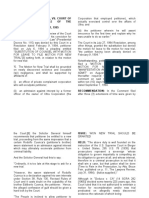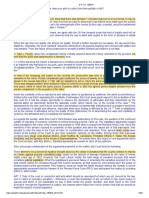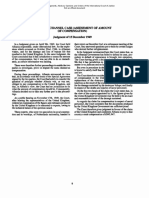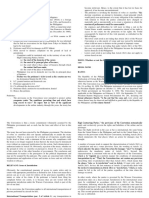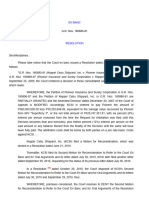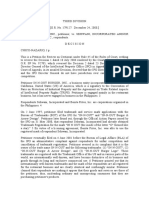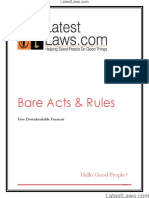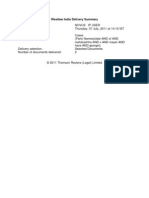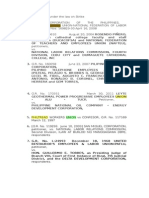ICJ - Asylum Case (Colombia V Peru) 1950 Judgment For Interpretation
ICJ - Asylum Case (Colombia V Peru) 1950 Judgment For Interpretation
Uploaded by
Rem RamirezCopyright:
Available Formats
ICJ - Asylum Case (Colombia V Peru) 1950 Judgment For Interpretation
ICJ - Asylum Case (Colombia V Peru) 1950 Judgment For Interpretation
Uploaded by
Rem RamirezOriginal Description:
Original Title
Copyright
Available Formats
Share this document
Did you find this document useful?
Is this content inappropriate?
Copyright:
Available Formats
ICJ - Asylum Case (Colombia V Peru) 1950 Judgment For Interpretation
ICJ - Asylum Case (Colombia V Peru) 1950 Judgment For Interpretation
Uploaded by
Rem RamirezCopyright:
Available Formats
Summaries of Judgments, Advisory Opinions and Orders of the International Court of Justice
Not an official document
REQUEST FOR INTERPRETATION OF THE JUDGMENT
OF 20 NOVEMBER 1950 INTHE ASYLUM CASE
Judgment of 27 November 1950
The judgment deals with the request for an interpretation (c) or, on the contrary, that Colombia is bound to surren-
of the Judgment which the Court had delivered on November der the refugee?
20th, in the Asylum Case (Colombia-Peru).This request had On the first question, the Court found that the point had not
been submitted to the Court in the name of the Colombian been submitted to it by the Parties: the Court had been asked
Government on the very day when the judgment to be inter- to decide only on n submission presented by Colombia in
preted was delivered. abstract and general terms.
By twelve votes to one the Court, including two judges ad The other two questions in reality amount to an alterna-
hoc, one designated by the Colombian Government and the tive, dealing with the surrender of the refugee. This point
other by the Peruvian Government, held that the request was also had not been included in the submissions of the Parties:
inadmissible. the Court therefore could make no decision upon it. It was for
the Parties to present their respective claims on this point,
which they abstained from doing. When Colombia claims to
detect "gaps" in the:Judgment, these gaps in reality concern
new points on whicih decision cannot be obtained by means
of an interpretation: this interpretation may in no way go
beyond the limits of the Judgment, as fixed in advance by the
In its Judgment, the Court recalls that the first condition submissions of the F'arties.
which must be fulfilled to enable it to give ;in interpretation Finally, the condition required by the Statute that there
under the provisions of the Statute, is that the real purpose of should be a dispute is not satisfied: no dispute between the
the request should be to obtain an interpretation of the Judg- Parties had been brought to the attention of the Court, and it
ment. This means that its object must be solely to obtain clar- is shown by the very date of the request for an interpretation
ification as to the meaning and scope of what had been that such a dispute clould not possibly have arisen in any way
decided by the Judgment with binding force. It is also neces- whatever.
sary that there should be a dispute between the Parties as to
the meaning and scope of that Judgment. For these reasons, the Court declared that the request for
an interpretation presented by Colombia was inadmissible.
The Court then notes that the Governme:nt of Colombia
asked it to reply to three questions: Is the Judgment of
November 20th, 1950, to be construed as meaning:
(a) that legal effects are to be attributed to the qualifica-
tion made by the Colombian Ambassador at Lima of the
offence imputed to M. Haya de la Torre? M. Caicedo Castilla, Judge ad hoc designated by the
Colombian Government, declared that he was unable to join
(b) that Peru is not entitled to demand surrender of the in the Judgment. Hiis declaration is appended to the Judg-
refugee, and that Colombia is not bound to s~lrrenderhim? ment.
You might also like
- Human Rights Attack Outline - Martin Flaherty, Columbia F 21Document11 pagesHuman Rights Attack Outline - Martin Flaherty, Columbia F 21Trevor RiceNo ratings yet
- Tax SecretsDocument3 pagesTax Secretshrpufnstuf100% (11)
- Summary of The Judgment - in The ASYLUM CASESDocument3 pagesSummary of The Judgment - in The ASYLUM CASESLace Torres Abasolo100% (2)
- Colombia V PerúDocument8 pagesColombia V PerúErika PotianNo ratings yet
- Asylum Case (ICJ Reports 1950)Document4 pagesAsylum Case (ICJ Reports 1950)JD BallosNo ratings yet
- The Haya de La Torre Case Between Colombia and Peru With Cuba As Intervening PartyDocument4 pagesThe Haya de La Torre Case Between Colombia and Peru With Cuba As Intervening PartyRobert ZrubanNo ratings yet
- Barcelona Traction CaseDocument3 pagesBarcelona Traction CaseJoseph De JesusNo ratings yet
- Armovit v. Court of Appeals, G.R. No. 154559, October 5, 2011Document2 pagesArmovit v. Court of Appeals, G.R. No. 154559, October 5, 2011KcompacionNo ratings yet
- Case of Certain Norwegian Loans - 1955Document2 pagesCase of Certain Norwegian Loans - 1955Oana Claudia GoguNo ratings yet
- Asylum Case: 20 November 1950 General List No. 7 International Court of JusticeDocument8 pagesAsylum Case: 20 November 1950 General List No. 7 International Court of JusticeIsabel Luchie GuimaryNo ratings yet
- Pale Digest Pool 35 65Document75 pagesPale Digest Pool 35 65janNo ratings yet
- Pale Digest Pool 35 65Document75 pagesPale Digest Pool 35 65Marcus PiroteNo ratings yet
- Realty Sale Enterprises vs. IACDocument2 pagesRealty Sale Enterprises vs. IACPMV100% (1)
- Armovit v. Court of Appeals, G.R. No. 154559 (October 5, 2011) FactsDocument9 pagesArmovit v. Court of Appeals, G.R. No. 154559 (October 5, 2011) FactsDan LocsinNo ratings yet
- Corpuz v. People, 29 April 2014-5Document1 pageCorpuz v. People, 29 April 2014-5suizyyyNo ratings yet
- Credit Cases FinalsDocument80 pagesCredit Cases Finalsaya5monteroNo ratings yet
- Case Comentray - PIL ASSIGNMENTDocument9 pagesCase Comentray - PIL ASSIGNMENTsapuni NayananayakeNo ratings yet
- Case DigestDocument105 pagesCase DigestNikkiNo ratings yet
- (G.R. NO. 190144 - August 1, 2012) Bank of The Philippine Islands, Petitioner, v. CARLITO LEE, Respondent. DecisionDocument105 pages(G.R. NO. 190144 - August 1, 2012) Bank of The Philippine Islands, Petitioner, v. CARLITO LEE, Respondent. DecisionNikkiNo ratings yet
- Kuwait Oil Tanker Company SAK V Qabazard (UKCA) (2002) EWCA Civ 34 PDFDocument10 pagesKuwait Oil Tanker Company SAK V Qabazard (UKCA) (2002) EWCA Civ 34 PDFAndrew ChongNo ratings yet
- Civ Pro 2nd Set Full TextDocument96 pagesCiv Pro 2nd Set Full TextMichael James DuazoNo ratings yet
- norway v. franceDocument2 pagesnorway v. francesanyashrivastava01No ratings yet
- Isaias Rodriguez Rodriguez v. Secretary of The Treasury of Puerto Rico, 276 F.2d 344, 1st Cir. (1960)Document7 pagesIsaias Rodriguez Rodriguez v. Secretary of The Treasury of Puerto Rico, 276 F.2d 344, 1st Cir. (1960)Scribd Government DocsNo ratings yet
- TRANSFIELDDocument2 pagesTRANSFIELDKDNo ratings yet
- Asylum CaseDocument4 pagesAsylum CaseGenn AngelesNo ratings yet
- Barcelona Traction Case (1964 Decision) PDFDocument3 pagesBarcelona Traction Case (1964 Decision) PDFjomsmanaigNo ratings yet
- Transfield Vs LuzonDocument9 pagesTransfield Vs LuzonJoseph Adrian ToqueroNo ratings yet
- Philippine National Bank vs. JumamoyDocument4 pagesPhilippine National Bank vs. JumamoyPACNo ratings yet
- Lhuillier vs. British Airways, G.R. No. 171092, March 15, 2010Document12 pagesLhuillier vs. British Airways, G.R. No. 171092, March 15, 2010Jennilyn Gulfan YaseNo ratings yet
- Nocum Vs Lucio TanDocument6 pagesNocum Vs Lucio TanChase DaclanNo ratings yet
- G.R. No. L-24756 October 31, 1968: Nemenzo v. SabillanoDocument2 pagesG.R. No. L-24756 October 31, 1968: Nemenzo v. SabillanoAnonymous 9BPI6hdNo ratings yet
- Asylum Case.Document4 pagesAsylum Case.Gennard Michael Angelo AngelesNo ratings yet
- The Asylum Case (Colombia v. Peru, 17 I.L.R. 28 I.C.J. Reports, 1950)Document2 pagesThe Asylum Case (Colombia v. Peru, 17 I.L.R. 28 I.C.J. Reports, 1950)Μιχαήλ εραστής του ροσαριούNo ratings yet
- 16 Bernabe V VergaraDocument1 page16 Bernabe V VergaraMarc LopezNo ratings yet
- Late Payment of Appeal Fees - JurisprudenceDocument10 pagesLate Payment of Appeal Fees - JurisprudenceJeff FernandezNo ratings yet
- 07 G.R. No. 191388Document12 pages07 G.R. No. 191388Faith LuberasNo ratings yet
- Corfu Channel SummaryDocument1 pageCorfu Channel SummarykatNo ratings yet
- 5. FRANCE V BRAZIL (BRAZILIAN LOANS CASE) PCIJ (1929)Document3 pages5. FRANCE V BRAZIL (BRAZILIAN LOANS CASE) PCIJ (1929)Jyzel Cris FactorNo ratings yet
- Anisminic LTD V Foreign Compensation Commission Anisminic LTDocument41 pagesAnisminic LTD V Foreign Compensation Commission Anisminic LTTyler ReneeNo ratings yet
- Luxembourg Court of AppealDocument16 pagesLuxembourg Court of AppealHollyRustonNo ratings yet
- Corfu Channel Case (Preliminary Objection) Judgment of MarchDocument2 pagesCorfu Channel Case (Preliminary Objection) Judgment of MarchIya AnonasNo ratings yet
- Forum Non Conveniens (1)Document4 pagesForum Non Conveniens (1)muhammadhamzatariq024No ratings yet
- WHEREFORE, Viewed From All The Foregoing, The Court Finds The Petition Unmeritorious and Denies The Same. PetitionerDocument12 pagesWHEREFORE, Viewed From All The Foregoing, The Court Finds The Petition Unmeritorious and Denies The Same. PetitioneropislotoNo ratings yet
- PIL-READINGS (Feb. 20)Document213 pagesPIL-READINGS (Feb. 20)SGNo ratings yet
- Asylum Case PDFDocument2 pagesAsylum Case PDFAnkit AnandNo ratings yet
- Barcelona Traction, Light Power & Co.Document2 pagesBarcelona Traction, Light Power & Co.KfMaeAseronNo ratings yet
- Digest Pool 2nd Wave CivProDocument12 pagesDigest Pool 2nd Wave CivProErnest Talingdan CastroNo ratings yet
- Evidence FinalsDocument21 pagesEvidence FinalsTen De Los SantosNo ratings yet
- de Jesus v. Sanchez-MalitDocument2 pagesde Jesus v. Sanchez-MalitKaren Joy MasapolNo ratings yet
- Bonsubre v. Yerro, 11 February 2015Document6 pagesBonsubre v. Yerro, 11 February 2015Jaime Rariza Jr.No ratings yet
- G.R. No. 95863 July 1, 1993 Part 5Document3 pagesG.R. No. 95863 July 1, 1993 Part 5Hanz KyNo ratings yet
- Banco Espanol-Filipino vs. Palanca 37 Phil 921Document8 pagesBanco Espanol-Filipino vs. Palanca 37 Phil 921Marianne Shen PetillaNo ratings yet
- Santos III Vs Northwest Orient AirlinesDocument3 pagesSantos III Vs Northwest Orient AirlinesCharles Dean RamosNo ratings yet
- De Jesus Vs ColladoDocument4 pagesDe Jesus Vs ColladoJM EnguitoNo ratings yet
- 2D Civpro Digests - Iv - IxDocument68 pages2D Civpro Digests - Iv - IxMalcolm CruzNo ratings yet
- G.R. Nos. 180880-81 (Resolution) - Keppel Cebu Shipyard, Inc. v. Pioneer Insurance and Surety CorpDocument10 pagesG.R. Nos. 180880-81 (Resolution) - Keppel Cebu Shipyard, Inc. v. Pioneer Insurance and Surety CorpReeze ToniNo ratings yet
- Case CrimproDocument7 pagesCase CrimproJia Chu ChuaNo ratings yet
- Pedro A. Mattei v. V/o Prodintorg, Libellant, 321 F.2d 180, 1st Cir. (1963)Document7 pagesPedro A. Mattei v. V/o Prodintorg, Libellant, 321 F.2d 180, 1st Cir. (1963)Scribd Government DocsNo ratings yet
- Salvanera vs. People G.R. No. 143093 May 21, 2007 FactsDocument2 pagesSalvanera vs. People G.R. No. 143093 May 21, 2007 FactsLauriz EsquivelNo ratings yet
- Supreme Court Eminent Domain Case 09-381 Denied Without OpinionFrom EverandSupreme Court Eminent Domain Case 09-381 Denied Without OpinionNo ratings yet
- California Supreme Court Petition: S173448 – Denied Without OpinionFrom EverandCalifornia Supreme Court Petition: S173448 – Denied Without OpinionRating: 4 out of 5 stars4/5 (1)
- The Nuremberg Trials (V. 2): Trial Proceedings From Preliminary Hearing Held on 14 November 1945 to 30 November 1945From EverandThe Nuremberg Trials (V. 2): Trial Proceedings From Preliminary Hearing Held on 14 November 1945 to 30 November 1945No ratings yet
- 40 GR 70890 - Libi Vs IACDocument14 pages40 GR 70890 - Libi Vs IACRem RamirezNo ratings yet
- GR 179127 - Inn-N-Out Burger Vs Sehwani (Benita's Frites)Document17 pagesGR 179127 - Inn-N-Out Burger Vs Sehwani (Benita's Frites)Rem RamirezNo ratings yet
- Howden Vs CIR, GR L-19392 (April 14, 1965)Document1 pageHowden Vs CIR, GR L-19392 (April 14, 1965)Rem RamirezNo ratings yet
- Ra 7832 - Irr PDFDocument7 pagesRa 7832 - Irr PDFRem RamirezNo ratings yet
- Posted Cmigs List (April 21 - July 01, 2014)Document109 pagesPosted Cmigs List (April 21 - July 01, 2014)Rem RamirezNo ratings yet
- PhilRES Letter To REBAP (041414)Document3 pagesPhilRES Letter To REBAP (041414)Rem RamirezNo ratings yet
- PRC Position Paper On AIPO AccreditationDocument10 pagesPRC Position Paper On AIPO AccreditationRem RamirezNo ratings yet
- AIPO Receipt Nos - 30 September 2013Document380 pagesAIPO Receipt Nos - 30 September 2013Rem RamirezNo ratings yet
- Aug 26 2013 - Special Board MeetingDocument2 pagesAug 26 2013 - Special Board MeetingRem RamirezNo ratings yet
- The Philippine EconomyDocument17 pagesThe Philippine EconomyKrysh AlorroNo ratings yet
- BDC EO New 2019Document2 pagesBDC EO New 2019Brgy. San Francisco Santa Catalina, Neg. OrientalNo ratings yet
- State Power and Transnational Activism - Jean GrugelDocument15 pagesState Power and Transnational Activism - Jean GrugelWegik PrasetyoNo ratings yet
- Karnataka Cinemas (Regulation) Act, 1964Document12 pagesKarnataka Cinemas (Regulation) Act, 1964Latest Laws TeamNo ratings yet
- PCT01-A - Different Kinds of TrustsDocument5 pagesPCT01-A - Different Kinds of Trusts2PlusNo ratings yet
- Islamic Ideology Council PakistanDocument10 pagesIslamic Ideology Council PakistanArif Masood100% (3)
- Pittsburg State University Journal of Managerial IssuesDocument18 pagesPittsburg State University Journal of Managerial IssuesBarbara CortatNo ratings yet
- The Ethical and Social Context of Management: What Is Ethics?Document9 pagesThe Ethical and Social Context of Management: What Is Ethics?zonayetgaziNo ratings yet
- Israel - Palestine ConflictDocument30 pagesIsrael - Palestine ConflictColonial LegislationNo ratings yet
- Activity CaviteMutinyDocument8 pagesActivity CaviteMutinyRoldan MapeNo ratings yet
- Jim Tucker - What Is BilderbergDocument11 pagesJim Tucker - What Is BilderbergGebo86No ratings yet
- Stae of Maharashtra V M H GeorgeDocument29 pagesStae of Maharashtra V M H GeorgeAnshu Raj Singh100% (2)
- French Riots For DummiesDocument12 pagesFrench Riots For DummiesHoover InstitutionNo ratings yet
- The Kings Popes and Parasites in American HistoryDocument24 pagesThe Kings Popes and Parasites in American HistoryTiger Dimension-El100% (1)
- LPTRP FlowchartDocument1 pageLPTRP FlowchartYisrael Ashkenazim0% (1)
- 2022 Nadesstu ReviewDocument30 pages2022 Nadesstu ReviewVictory Ojugba100% (1)
- Training To Change Attitude To Prevent and Punish Sexual ViolenceDocument46 pagesTraining To Change Attitude To Prevent and Punish Sexual ViolenceVolodymyr DOBROVOLSKYINo ratings yet
- Case Assignment For 4th YearDocument2 pagesCase Assignment For 4th YearSean McleanNo ratings yet
- Victor Manuel Chevere v. Jerry Johnson Stephen Kaiser Rick E. Peters Jim Keith Bob Affolter, 38 F.3d 1220, 10th Cir. (1994)Document4 pagesVictor Manuel Chevere v. Jerry Johnson Stephen Kaiser Rick E. Peters Jim Keith Bob Affolter, 38 F.3d 1220, 10th Cir. (1994)Scribd Government DocsNo ratings yet
- The Gülen Movement)Document309 pagesThe Gülen Movement)Alexandru Matei100% (1)
- Nagel Chapter 8 For AnnotationDocument7 pagesNagel Chapter 8 For AnnotationMa. Odessa C. FurtoNo ratings yet
- 1st QuizDocument3 pages1st QuizAbegail CastroNo ratings yet
- Digest MainDocument116 pagesDigest Mainmithun7No ratings yet
- Chapter 7 Corruption and Ethics in Global BusinessDocument31 pagesChapter 7 Corruption and Ethics in Global BusinessyukiNo ratings yet
- Philosophy of Law Midterms NotesDocument38 pagesPhilosophy of Law Midterms NotesAngelica Czarina DENSINGNo ratings yet
- Test Ii: Modified True or False DIRECTIONS: Write TRUE If The Given Questions/ Statements Are Correct and If False, Change The UnderlinedDocument3 pagesTest Ii: Modified True or False DIRECTIONS: Write TRUE If The Given Questions/ Statements Are Correct and If False, Change The UnderlinedJulie Ann EstradaNo ratings yet
- Rophy & Nigusse ThesisDocument17 pagesRophy & Nigusse Thesisnigussetarekegn74No ratings yet
- Dizon-Rivera v. DizonDocument7 pagesDizon-Rivera v. DizonRavenFoxNo ratings yet










